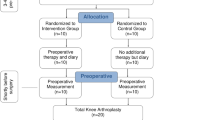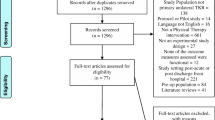Abstract
Purpose
This study aimed to compare progressive muscle relaxation (PMR) + standard physiotherapy (PT) to standard PT during inpatient rehabilitation of total knee arthroplasty (TKA) patients in terms of post-operative outcomes. The hypothesis was that PMR + standard PT would lead to better pain, function, and neuromuscular outcomes than standard PT.
Methods
A total of 106 patients were randomly allocated into PMR or standard rehabilitation (SR) groups. Both groups received standard PT during their hospital stay. PMR group additionally performed PMR exercise on post-operative days 1, 2, and 3. Patients were evaluated regarding pain intensity, functional outcomes, muscle strength, active range of motion, knee edema, anxiety, depression, and kinesiophobia.
Results
There were no differences between groups at baseline (n.s.). During the inpatient period and at discharge, the PMR group had better results in terms of pain relief (p < 0.05), quadriceps strength (p = 0.001), kinesiophobia level (p = 0.011) compared to the SR group. No difference was detected between groups regarding other evaluation parameters during the inpatient period, at discharge, and third post-operative month (n.s.). The within-group analysis showed statistically significant differences over time in both groups in each variable (p < 0.05).
Conclusion
Our findings support that PMR therapy offers beneficial results in subjective and objective measures of TKA patients during the inpatient period. Therefore, PMR therapy could be implemented into the rehabilitation program of TKA patients to enhance their early recovery from various symptoms following TKA.
Level of evidence
II.

Similar content being viewed by others
References
Alattas SA, Smith T, Bhatti M, Wilson-Nunn D, Donell S (2017) Greater pre-operative anxiety, pain and poorer function predict a worse outcome of a total knee arthroplasty. Knee Surg Sports Traumatol Arthrosc 25:3403–3410
Archer KR, Coronado RA, Wegener ST (2018) The role of psychologically informed physical therapy for musculoskeletal pain. Curr Phys Med Rehabil Rep 6:15–25
Aydemir Ö, Guvenir T, Kuey L, Kultur S (1997) Validity and reliability of Turkish version of hospital anxiety and depression scale. Turk J Psychiatry 8:280–287
Baird CL, Sands L (2004) A pilot study of the effectiveness of guided imagery with progressive muscle relaxation to reduce chronic pain and mobility difficulties of osteoarthritis. Pain Manag Nurs 5:97–104
Boerger TO, Aglietti P, Mondanelli N, Sensi L (2005) Mini-subvastus versus medial parapatellar approach in total knee arthroplasty. Clin Orthop Relat Res 440:82–87
Brunelli S, Morone G, Iosa M, Ciotti C, De Giorgi R, Foti C et al (2015) Efficacy of progressive muscle relaxation, mental imagery, and phantom exercise training on phantom limb: a randomized controlled trial. Arch Phys Med Rehabil 96:181–187
Cai L, Gao H, Xu H, Wang Y, Lyu P, Liu Y (2018) Does a program based on cognitive behavioral therapy affect kinesiophobia in patients following total knee arthroplasty? a randomized, controlled trial with a 6-month follow-up. J Arthroplasty 33:704–710
Cupal DD, Brewer BW (2001) Effects of relaxation and guided imagery on knee strength, reinjury anxiety, and pain following anterior cruciate ligament reconstruction. Rehabil Psychol 46:28–43
Driver C, Lovell GP (2021) Physiotherapists’ views, perceived knowledge, and reported use of psychosocial strategies in practice. Physiother Theory Pract 37:135–148
Edwards PK, Mears SC, Lowry Barnes C (2017) Preoperative education for hip and knee replacement: never stop learning. Curr Rev Musculoskelet Med 10:356–364
Eymir M, Erduran M, Ünver B (2020) Active heel-slide exercise therapy facilitates the functional and proprioceptive enhancement following total knee arthroplasty compared to continuous passive motion. Knee Surg Sports Traumatol Arthrosc. https://doi.org/10.1007/s00167-020-06181-4
Eymir M, Yuksel E, Unver B, Karatosun V (2021) Hand-held dynamometry in the inpatient care setting after total knee arthroplasty: reliability of static knee strength measurements. Am J Phys Med Rehabil 100:570–575
Farrar JT, Young JP Jr, LaMoreaux L, Werth JL, Poole MR (2001) Clinical importance of changes in chronic pain intensity measured on an 11-point numerical pain rating scale. Pain 94:149–158
Güney-Deniz H, Irem Kınıklı G, Çağlar Ö, Atilla B, Yüksel İ (2017) Does kinesiophobia affect the early functional outcomes following total knee arthroplasty? Physiother Theory Pract 33:448–453
Jacob S, Sharma S (2018) Efficacy of progressive muscular relaxation on coping strategies and management of stress, anxiety and depression. Int J Indian Psychol 6:106–124
Larsen JB, Mogensen L, Arendt-Nielsen L, Madeleine P (2020) Intensive, personalized multimodal rehabilitation in patients with primary or revision total knee arthroplasty: a retrospective cohort study. BMC Sports Sci Med Rehabil 12:5
Lin PC (2012) An evaluation of the effectiveness of relaxation therapy for patients receiving joint replacement surgery. J Clin Nurs 21:601–608
McCallie MS, Blum CM, Hood CJ (2006) Progressive muscle relaxation. J Hum Behav Soc Environ 13:51–66
Meier W, Mizner RL, Marcus RL, Dibble LE, Peters C, Lastayo PC (2008) Total knee arthroplasty: muscle impairments, functional limitations, and recommended rehabilitation approaches. J Orthop Sports Phys Ther 38:246–256
Mizner RL, Snyder-Mackler L (2005) Altered loading during walking and sit-to-stand is affected by quadriceps weakness after total knee arthroplasty. J Orthop Res 23:1083–1090
Moukarzel M, Di Rienzo F, Lahoud JC, Hoyek F, Collet C, Guillot A et al (2019) The therapeutic role of motor imagery during the acute phase after total knee arthroplasty: a pilot study. Disabil Rehabil 41:926–933
Narin S, Unver B, Bakirhan S, Bozan O, Karatosun V (2014) Cross-cultural adaptation, reliability and validity of the Turkish version of the Hospital for Special Surgery (HSS) Knee Score. Acta Orthop Traumatol Turc 48:241–248
Nunes GS, Yamashitafuji I, Wageck B, Teixeira GG, Karloh M, de Noronha M (2016) Reliability of Volumetry and Perimetry to Assess Knee Volume. J Sport Rehabil 25:1–5
Pinto BL, McGill SM (2020) Voluntary muscle relaxation can mitigate fatigue and improve countermovement jump performance. J Strength Cond Res 34:1525–1529
Raad G, Tanios J, Azoury J, Daher A, Fakih C, Bakos HW (2021) Neurophysiology of cognitive behavioural therapy, deep breathing and progressive muscle relaxation used in conjunction with ART treatments: a narrative review. Hum Reprod Update 27:324–338
Shields RK, Enloe LJ, Evans RE, Smith KB, Steckel SD (1995) Reliability, validity, and responsiveness of functional tests in patients with total joint replacement. Phys Ther 75:169–176 (Discussion 176-169)
Stevens JE, Mizner RL, Snyder-Mackler L (2003) Quadriceps strength and volitional activation before and after total knee arthroplasty for osteoarthritis. J Orthop Res 21:775–779
Thomas AC, Judd DL, Davidson BS, Eckhoff DG, Stevens-Lapsley JE (2014) Quadriceps/hamstrings co-activation increases early after total knee arthroplasty. Knee 21:1115–1119
Tod D, Edwards C, McGuigan M, Lovell G (2015) A systematic review of the effect of cognitive strategies on strength performance. Sports Med 45:1589–1602
Tod DA, Thatcher R, McGuigan M, Thatcher J (2009) Effects of instructional and motivational self-talk on the vertical jump. J Strength Cond Res 23:196–202
Unver B, Baris RH, Yuksel E, Cekmece S, Kalkan S, Karatosun V (2017) Reliability of 4-meter and 10-meter walk tests after lower extremity surgery. Disabil Rehabil 39:2572–2576
Unver B, Karatosun V, Bakirhan S (2009) Reliability of goniometric measurements of flexion in total knee arthroplasty patients: with special reference to the body position. J Phys Ther Sci 21:257–262
Wang TJ, Chang CF, Lou MF, Ao MK, Liu CC, Liang SY et al (2015) Biofeedback relaxation for pain associated with continuous passive motion in Taiwanese patients after total knee arthroplasty. Res Nurs Health 38:39–50
Whale K, Wylde V, Beswick A, Rathbone J, Vedhara K, Gooberman-Hill R (2019) Effectiveness and reporting standards of psychological interventions for improving short-term and long-term pain outcomes after total knee replacement: a systematic review. BMJ Open 9:e029742
Wylde V, Rooker J, Halliday L, Blom A (2011) Acute postoperative pain at rest after hip and knee arthroplasty: severity, sensory qualities and impact on sleep. Orthop Traumatol Surg Res 97:139–144
Yilmaz O, Yakut Y, Uygur F, Ulug N (2011) Turkish version of the Tampa scale for Kinesiophobia and its test-retest reliability. Turk J Physiother Rehabil 22:44–49
Yuksel E, Kalkan S, Cekmece S, Unver B, Karatosun V (2017) Assessing minimal detectable changes and test-retest reliability of the timed up and go test and the 2-minute walk test in patients with total knee arthroplasty. J Arthroplasty 32:426–430
Acknowledgements
The authors appreciate all the people who cooperated in this research.
Funding
There was no funding for this study.
Author information
Authors and Affiliations
Corresponding author
Ethics declarations
Conflict of interest
All authors declare that they have no conflict of interest.
Ethical approval
This study was approved by the Local Medical Ethical Committee.
Additional information
Publisher's Note
Springer Nature remains neutral with regard to jurisdictional claims in published maps and institutional affiliations.
Rights and permissions
About this article
Cite this article
Eymir, M., Unver, B. & Karatosun, V. Relaxation exercise therapy improves pain, muscle strength, and kinesiophobia following total knee arthroplasty in the short term: a randomized controlled trial. Knee Surg Sports Traumatol Arthrosc 30, 2776–2785 (2022). https://doi.org/10.1007/s00167-021-06657-x
Received:
Accepted:
Published:
Issue Date:
DOI: https://doi.org/10.1007/s00167-021-06657-x




